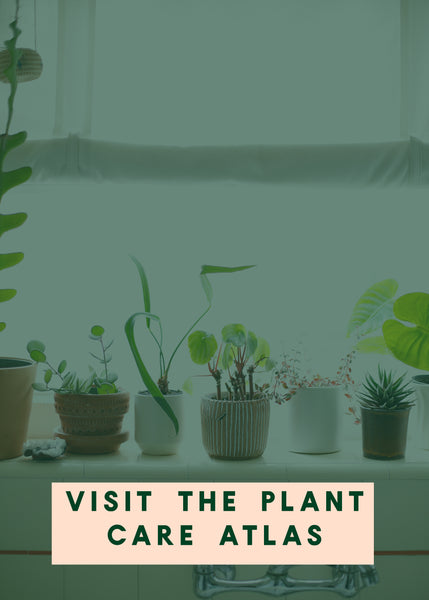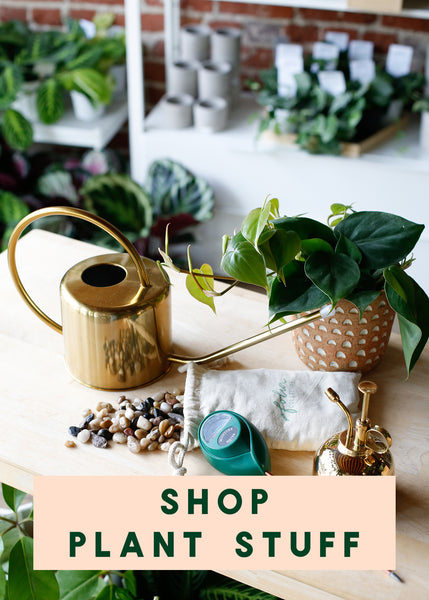Ask A Plant Pro: Yellowing Leaves

Every month on our Instagram account we will open up a question box for you to submit your plant questions. Think of it like a Dear Abby column but for plant-related questions. If we select your question, we'll send a treat to your Instagram inbox.
Dear Plant Pro: My plant's leaves are turning yellow. How do I accurately identify what is wrong?
-Stumped in South LA

| Common Reasons Plant Leaves May Turn Yellow | Action Steps |
| Lack of light: Light is the most important factor for healthy plants and a lack of light often manifests as yellowing leaves. | Double check the light needs of the particular plant and if you're not providing it with enough, adjust the placement of the plant to get it into the correct level of light. |
|
Adaption to a new environment: As a plant adjusts to new conditions (especially when moving from a bright greenhouse to our not-so-bright homes), it's natural for some yellowing and leaf-loss to occur. |
Ensure you're creating the optimal conditions for the plant (enough natural light, adequate humidity, correct watering, etc). If you're not able to create optimal conditions and the plant is a species that can tolerate less ideal conditions (like an Epipremnum [Pothos] or ZZ Plant), then you just need to accept that the plant will lose some leaves as it finds an equilibrium with the available resources. |
|
Incorrect watering: watering goes hand-in-hand with light - the more light a plant gets, the faster it will use the water stored in the soil. If the balance between how much water is in the soil and the amount of light the plant receives is off, some plants will exhibit yellow leaves as a sign of that imbalance. This goes both directions - too much water can cause yellowing, but too little water can as well. |
First, be sure you're using sound watering practices. This means:
If you've got your watering method dialed in, you'll also want to ensure your timing is correct. I advise against watering on a schedule and instead recommend checking the soil on a schedule and only watering when it's at the correct level of dryness. This will vary from plant to plant, so if you're not sure how far your plant wants to dry out between waterings, look it up or ask. |
|
Pests: some pests can cause leaf yellowing as they sap nutrients from the plant while they feed. Different pests will cause different kinds of damage to leaves - some leave spots or a pattern, others a little trail, and some cause even yellowing across the whole leaf. |
Anytime you have a mystery plant problem, it's always a good idea to check for pests - just in case. The most common houseplant pests are spider mites, mealybugs, thrips, scale, aphids, and fungus gnats. Learn to identify each of these because you're likely to encounter them at least once in your plant parenthood journey. Do an internet search to see images of each in various stages of their life cycle and remember that most are very small so you may need to use magnification in order to properly identify them. Once you've identified the pest, follow the corresponding course of treatment as well as prevention guidelines. My book, Houseplants For All, has an entire section dedicated to pest management, and we'll be adding more content to the blog to help with pests in the coming months. |
|
Nutrient deficiency: over time, the available nutrients in potting mix are depleted and since an indoor plant or containerized plant can't pull nutrients from their surrounding environment like a plant growing in the ground outdoors can, we have to add those nutrients back to the soil via fertilizer. Too little or too much of a specific nutrient can manifest in various leaf discolorations, but the most common nutrient related issue in houseplants is either a lack of fertilizer overall, or too much fertilizer. |
If your entire plant appears pale in color (even if not exactly yellow), or growth seems stunted, and you know you haven't fertilized in over 6 months, your plant is likely suffering from a lack of fertilizer. Apply an appropriate fertilizer (any product indicated for houseplants is a safe choice), and wait to see if your plant's appearance rebounds. If your plant's leaves have yellowing patches that often lead to crispy/brown patches, and/or you can see a visible crust of built-up fertilizer salts on the surface of the soil, you've probably used too much fertilizer (or a formula that's too strong or wasn't properly diluted). Remove any affected leaves, and if that 'crust' is present on the soil, scrape it away. Then flush the soil by running water through for several minutes, allow to drain, and repeat 3-4 times to flush excess fertilizer out. Refrain from fertilizing again for a few months. |
All in all, when yellow leaves appear, my best advice is:
- Don't panic!
- Rule out normal causes that are outside of your control.
- Be thankful your plant can 'communicate' with you through these yellowing leaves so you can make care adjustments and help it live its healthiest life!
Have a more specific plant question? Visit the Plant Care Help Desk and submit your questions via our google form.





